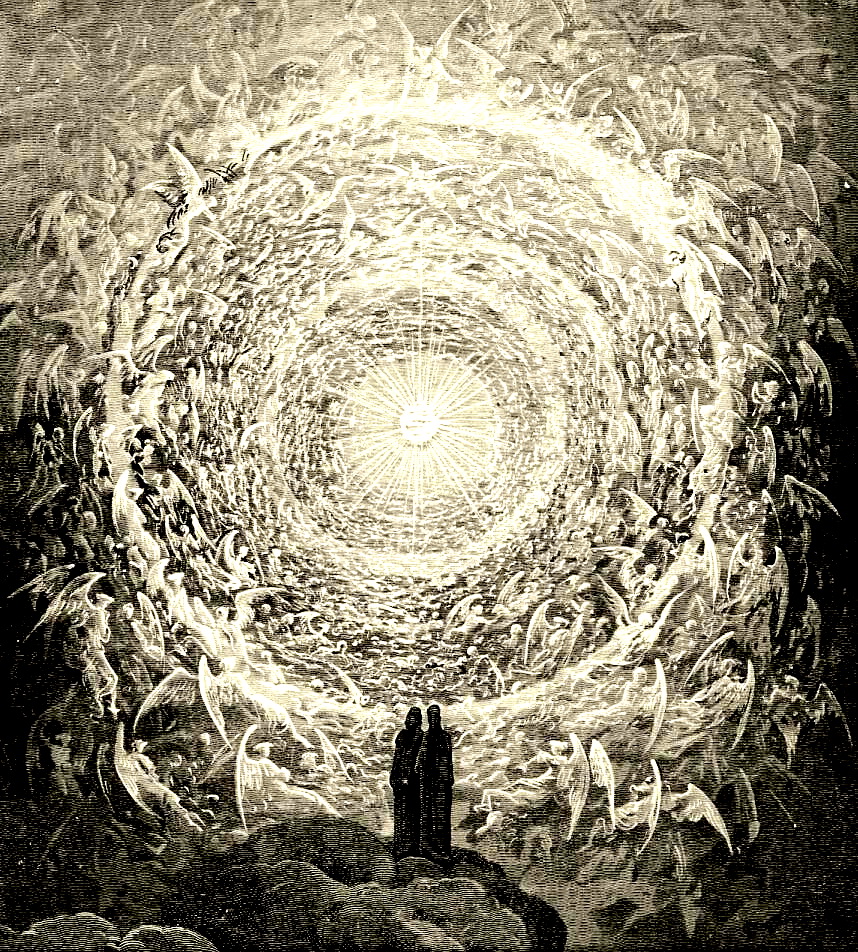
Too often when one hears talk about the spiritual world (or the world of spirits), two simple but insidious errors slip into our imagination. If they take hold, they keep us light-years from ever getting an even approximate idea of what we are talking about. Our world of matter in all its forms – gross and subtle – contains much that is heavy, opaque and cold. Although there is plenty of light and energy darting about, when we think of matter, we tend to point to a brick, or a handful of dirt, or a mountain. So when we fashion ourselves a picture of the immaterial world, we understandably (and not incorrectly) suppose it to be light, translucent and, in some sense, diaphanous. No problem with this, as long as we acknowledge the metaphorical nature of these terms. But we begin to get it all wrong when we presume that the spiritual world is therefore evanescent, rarefied, less than substantial, and – above all – homogeneous and radically simple. The truth of the matter is: it is not.
When we think ‘light’, we are liable to also think gaseous, diffuse, gossamery, misty – none of which even remotely applies to spiritual realities. All that we see and touch in the material world, which seems to be so robustly real, dense and present, is in fact but a remote, material instance of an idea, an archetype, a spiritual – indeed intellectual – anticipation in the mind of God, and one which pre-exists before (and even during and after!) its brief epiphany here below. It is far more robustly real, dense and present in its transcendent and original matrix than any of the objects and phenomena currently occurring in the physical cosmos – “just passing through,” as it were.
Now, after showing my Platonic cards, let me deal my Aristotelian hand. The physical things around us – and we ourselves are among them – bear more than just passing reflections of those archetypes. The Platonic Forms in the mind of God are potent indeed, and when the Biblical truth about creation is fully factored in, the substances and accidents in the world take on a solidity and meaning beyond what an all-too-otherworldly version of Platonism would allow. That is why Christian theology, after a prolonged honeymoon with Plato, finally mated its deepest incarnational truths to empirical Aristotle. In the end, these two luminaries – Plato and Aristotle – both have unmistakable positions of prominence in the Christian firmament. Attempts to diminish either of them inevitably ends up darkening the stained glass windows of revealed truth.
My point here, however, is that there is a direct correlation between the richness and complexity of the cosmos and the richness and complexity of the spiritual world beyond it (though not ‘outside’ of it). More yet, since our present universe is just one of infinite possibilities, the divine ‘storehouse’ of archetypal projects must needs exceed by endless measure this particular cosmos. Even though current statistics put the universe’s galaxy count in excess of two trillion, all of that megaspace is in fact very small, in fact incommensurately diminutive in comparison to the sum of all the Ideas, all the Forms, lying potentially in the world-projecting thought of the Logos.
But let us stay with current created reality (if I may put it thus). The created spiritual world is, according to the Abrahamic faiths, not just a grand reservoir of ontological blueprints, standing forth from the infinite resources of the Almighty, and serving as stable paradigms for the shifting material things presently in space and time. That world is above all occupied by that sovereign category of reality that displays by far the most dense and intense ontological consistency of all: persons.

Persons are both ontologically dense, and operationally intense. Put in less fancy terms, they really are fully and solidly real, and when they act, big things happen. The spiritual world consists, in the main, not of things or forces or vapors or atmospheres, but of millions and millions of persons. Imagine the combined population of Mexico City and São Paulo, surrounding you on all sides: left, right, front, center, above and below; translate that into bodiless angels, you might get the idea. And to our opening remarks, nothing is less ‘homogeneous’ than a multitude of intelligent subjects and agents, for each is, unto itself a mini-world in person. So just in terms of being, the spiritual world is incomparably more ‘real’ than any universe of thermonuclear stars and scattered star-dust, however ‘big’ (see my other post: Bigger and Bigger Emptiness‘).
So much for the first error about the spiritual. It is not ontologically homogeneous – far from it. But the other error is even more widespread, and actually surpasses the first in treacherous confusion. Probably emanating (pun intended) from early Neo-Platonic, and certainly from early Gnostic and Manichean sources is the idea that spirit is somehow synonymous with goodness. The more ‘spiritualized’ you get, the more morally upright and saintly, this error suggests. Evil, in turn, seems inevitably gummed up with that viscous, opaque and heavy matter we mentioned before – and in particular with that highly-charged version of it called flesh. Well, we got this one wrong too.
 According to all the major religious traditions – and not too far behind them, most of the world’s more robust ethical systems – the source and summit of evil lies not in the flesh, but in the spirit. Even in the Adam and Eve story, it wasn’t sexual hanky-panky that first got our proto-parents in trouble with God, but a free, intellectually informed choice of the will. And even before this – as per the Christian theological tradition – the inaugural sin in God’s creation was committed not by a pack of over-sexed imps, but rather by the pure spirits, the angels; and the name of the delinquency is pride. That the proud may, after their fall, find themselves singularly vulnerable to carnal sin is a consequence and not a cause. We became rakish because we were first proud.
According to all the major religious traditions – and not too far behind them, most of the world’s more robust ethical systems – the source and summit of evil lies not in the flesh, but in the spirit. Even in the Adam and Eve story, it wasn’t sexual hanky-panky that first got our proto-parents in trouble with God, but a free, intellectually informed choice of the will. And even before this – as per the Christian theological tradition – the inaugural sin in God’s creation was committed not by a pack of over-sexed imps, but rather by the pure spirits, the angels; and the name of the delinquency is pride. That the proud may, after their fall, find themselves singularly vulnerable to carnal sin is a consequence and not a cause. We became rakish because we were first proud.
The notion that the ‘spiritual’ is all sweetness and light, and that those who commune with it float on clouds of rarefied oneness with scents of sanctity in their nostrils, is a joke. How should we, then, think about the spiritual world? We should at least get the following straight: it is not only ontologically heterogeneous, but also morally differentiated. If you wish to ‘plug into’ a spirituality, be careful what port of entry you choose, for they are legion. True, there is a vast landscape of regions of light and love, but in the ‘spiritual’ world you will also run into mesmerizing and stupefying worlds of unspeakable evil. Reality is a tough environment to live in, but holds great promise for the valiant.



